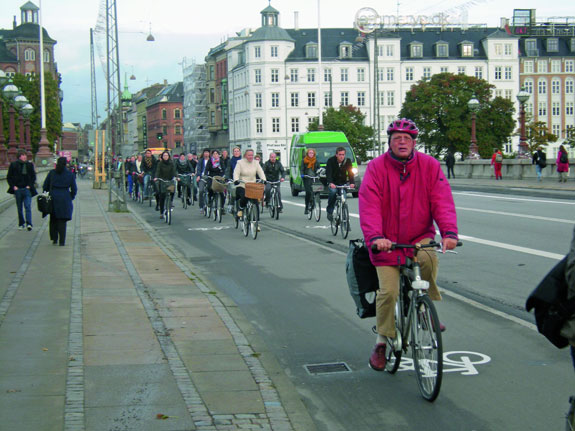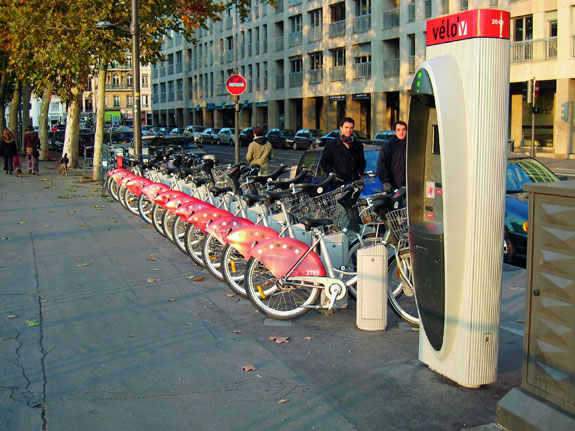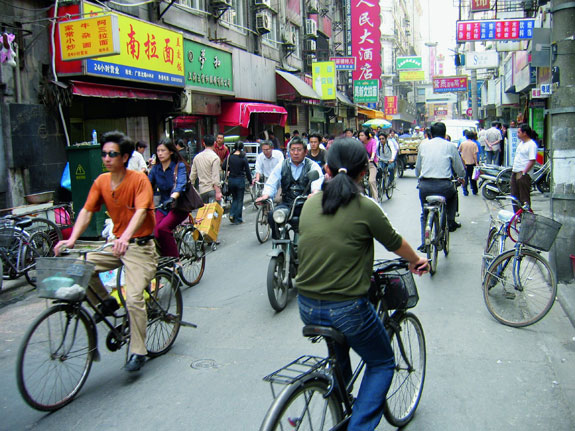Danish Architect Jan Gehl on Good Cities for Bicycling
2:43 PM PDT on June 16, 2011
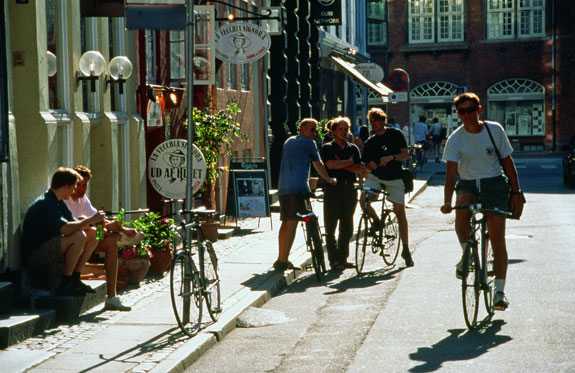
Editor’s note: This is the final installment in our series this week featuring Danish architect and livable streets luminary Jan Gehl. The pieces are excerpts from his book, “Cities for People” published by Island Press. Donate to Streetsblog SF and you’ll qualify to win a copy of the book, courtesy of Island Press.
Bicyclists represent a different and somewhat rapid form of foot traffic, but in terms of sensory experiences, life and movement, they are part of the rest of city life. Naturally, bicyclists are welcome in support of the goal to promote lively, safe, sustainable and healthy cities. The following is about planning good cities for bicyclists, and is handled relatively narrowly and in direct relation to a discussion on the human dimension in city planning.
Around the world there are numerous cities where bicycles and bicycle traffic would be unrealistic. It is too cold and icy for bicycles in some areas, too hot in others. In some places the topography is too mountainous and steep for bicycles. Bicycle traffic is simply not a realistic option in those situations. Then there are surprises like San Francisco, where you might think bicycling would be impractical due to all the hills. However, the city has a strong and dedicated bicycle culture. Bicycling is also popular in many of the coldest and warmest cities, because, all things considered, even they have a great number of good bicycling days throughout the year.
The fact remains that a considerable number of cities worldwide have a structure, terrain and climate well suited for bicycle traffic. Over the years, many of these cities have thrown their lot in with traffic policies that prioritized car traffic and made bicycle traffic dangerous or completely impossible. In some places extensive car traffic has kept bicycle traffic from even getting started.
In many cities, bicycle traffic continues to be not much more than political sweet talk, and bicycle infrastructure typically consists of unconnected stretches of paths here and there rather than the object of a genuine, wholehearted and useful approach. The invitation to bicycle is far from convincing. Typically in these cities only one or two percent of daily trips to the city are by bicycle, and bicycle traffic is dominated by young, athletic men on racing bikes. There is a yawning gap from that situation to a dedicated bicycle city like Copenhagen, where 37 percent of traffic to and from work or school is by bicycle. Here bicycle traffic is more sedate, bicycles are more comfortable, the majority of cyclists are women, and bicycle traffic includes all age groups from school children to senior citizens.
At a time when fossil fuel, pollution and problems with climate and health are increasingly becoming a global challenge, giving higher priority to bicycle traffic would seem like an obvious step to take. We need good cities to bike in and there are a great many cities where it would be simple and cheap to upgrade bicycle traffic.
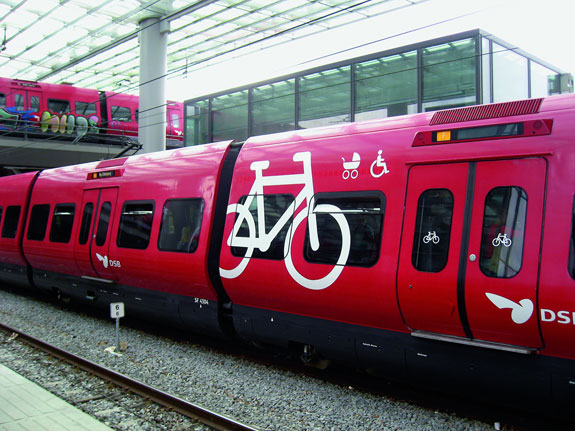
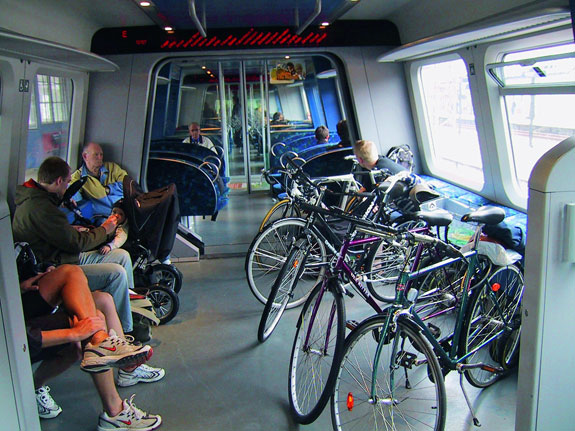
A Whole Hearted Bicycle Policy
The cities that have successfully promoted bicycle traffic in recent decades can be tapped for good ideas and requirements for becoming a good bicycle city. Copenhagen is a compelling example of a city whose longstanding bicycle tradition came under threat from car traffic in the 1950s and 1960s. However, the oil crises in the 1970s were the catalyst for a targeted approach to inviting people to ride their bicycles more. And the message was received: today bicycles make up a considerable part of city traffic, and have helped keep vehicular traffic at an unusually low level compared to other large cities in Western Europe. The experiences from Copenhagen are used in the following to provide a platform for discussion about the good bicycle city.
In Copenhagen, a cohesive network for bicycles comprising all parts of the city has gradually been established. Traffic is so quiet on small side streets and residential streets in 15 and 30 km per hour/9 and 19 mph zones that a special cycle network is not necessary, but all major streets have one. On most streets, the network consists of bicycle paths along the sidewalks, typically using the curbstones as dividers toward the sidewalk, as well as parking and driving lanes. In some places bike lanes are not delimited by curbstones, but rather marked with painted stripes inside a row of parked cars, so that the cars protect the bicycles from motorized traffic. In fact, this system is known as “Copenhagen-style bicycle lanes.”
Another link in the city’s bicycle system is green bicycle routes, which are dedicated bike routes through city parks and along discontinued railway tracks. These paths are intended for bicycles in transit and are viewed as a supplementary opportunity, a sightseeing possibility and a green option for bicycles. However, the main principle of bicycle policy is for bicycles to have room on ordinary streets, where just like the others in traffic, their owners have errands in shops, residences and offices. The principle is for bicycle traffic to be safe from door to door throughout the city.
Room for this comprehensive bicycle network has been largely gained by downsizing car traffic. Parking space and driving lanes have been gradually reduced, as traffic patterns have moved from car to bicycle traffic, and therefore bicycles needed more room. Most of the city’s major four-lane streets have been converted to two-lane streets with two bicycle paths, two sidewalks and a broad median strip intended to make it safer for pedestrians to cross the street. Roadside trees have been planted and traffic is two-way as before.
Bicycle paths are placed along sidewalks in the same direction as ve- hicular traffic, and are always on the right and thus “slow” side of vehicular traffic. That way all traffic groups know — more or less — where they have the bicycles, which is the safest system for all parties.
Bicycles as Part of Integrated Transport Thinking
The invitation to bike must mean that bicycle traffic is integrated into the overall transport strategy. It has to be possible to bring bikes on trains and the metro lines, and preferably in city buses so that it is possible to travel by combining bike trips with public transport. Taxis too must be able to transport bicycles when needed.
Another important link in an integrated transport policy is the possibility to park bicycles securely at stations and traffic hubs. Good bicycle parking options are also needed along streets in general, at schools, offices and dwellings. New offices and industrial buildings should include bicycle parking, changing rooms and showers for bicyclists as a natural part of their planning.
Traffic safety is a crucial element in overall bicycle strategies. A cohesive bicycle network protected by curbstones and parked cars is an important first step. Another key concern is the experienced and real safety of the city’s intersections. Copenhagen is working on several strategies. Large intersections have special bicycle lanes of blue asphalt and bicycle icons to remind drivers to watch out for bicycles. Intersections also have special light signals for bicycles, which typically give a green light to bicycle traffic six seconds before cars are allowed to move. Trucks and buses are required to have special bicycle mirrors and frequent media campaigns admonish drivers to watch out for bicycles, particularly at intersections.
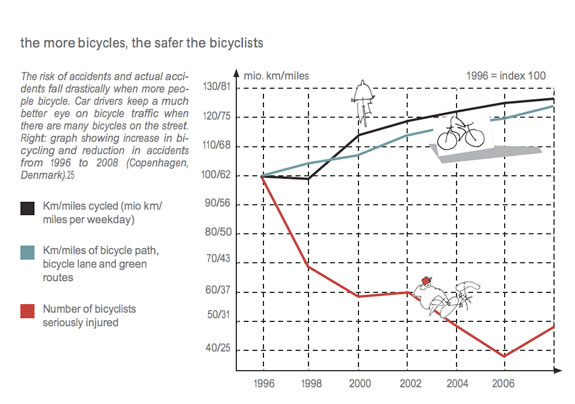
Good bicycle cities know that good visibility at intersections is vital. In Denmark vehicles are not allowed to park closer than 10 meters/33 feet from an intersection for this very reason. The widespread American practice of allowing cars to “turn right on red” at intersections is unthinkable in cities that want to invite people to walk and bicycle.
The volume of bicycle traffic is one of the most significant safety factors for making bicycle systems safe. The more bicycles there are, the more it forces drivers to watch out for bicyclists and be constantly on guard. There is a considerable positive effect when bicycle traffic reaches a reasonable “critical mass.”
A Comfortable Network
It is also relevant to mention comfort and amenity value in terms of bicycle networks. Bicycle trips can be pleasant, interesting and free of unnecessary irritations, or they can be boring and difficult. Many of the criteria for good places to walk can be transferred to bicycle routes. It is important for bicycles to have enough room so that they won’t be pushed or crowded. Bicycle paths in Copenhagen vary in width from 1.7 to 4 meters/5.5 to 13 feet, with 2.5 meters/8.2 feet as the recommended minimum.
As bicycle traffic is gradually developed into a versatile, popular transport system, many new and wider bicycles appear on the street scene. These include three-wheeled transport bicycles for children and goods, handicap bicycles and bicycle taxis. All of these transport options require room, and senior bikers as well as the many parents who transport their children by bicycle need increased reassurance that they won’t be pushed and crowded. As bicycle traffic successfully develops as an alternative transport system, more room is needed. Despite the new demands for more room, the bicycle continues to be the superior means of wheeled transport, which requires the smallest amount of room per person in the streets of the city.
A study conducted in Copenhagen in 2005 concluded that one of the city’s most pressing problems was heavy congestion on bicycle paths. The city council has since adopted an expansion of the width of bicycle paths in the most popular streets and is currently carrying out this policy.
Frequent interruptions are irritating and destroy the rhythm of the bicycle trip. Over the years Copenhagen has introduced several solutions to reduce the problem. Bicycle paths are often carried across minor side streets without interruption, which results in bicycle trips with fewer interruptions and lets drivers know they must wait. Introducing green waves for bicycles on selected street helps correspondingly to reduce irritating stops. In order to create these green bicycle waves, stoplights are set so that when bicycles bike at about 20 km/h (12.4 mph) they need not stop when they bike to and from the city during rush hour. That service used to be provided for cars. Another form of comfort and safety for bicyclists in Copenhagen is the city practice of snow removal. The bicycle lanes are always cleared before driving lanes to emphasize bicycle priority and the invitation to bike — despite the season.
Bicycle Cities and City Bicycles
In recent years, many cities have introduced various types of city bicycles that can be borrowed or rented from stands or depots. The idea is to reinforce bicycle traffic by making it easier for people to use bicycles for short trips in the city, while providing a collective bicycle system so that individuals do not need to buy, store and repair their own bicycles. Amsterdam’s white bicycle bike-share system came and disappeared quickly from the street scene in the 1970s. More stable and well organized systems were established in the 1990s, in Copenhagen, for example. Today Copenhagen has 2,000 city bicycles available at 110 bicycle stations in the city center. The bicycles are free, financed by advertisements. Users pay a coin deposit, which is returned when the borrowed bicycle is returned to one of the official bicycle racks. Copenhagen’s city bikes are used primarily by tourists, who can bicycle around town easily and safely, thanks to the well developed bicycle network. Copenhageners rarely borrow city bicycles, because they prefer their own bikes. In brief, the principle underlying city bikes in Copenhagen is to enable inexperienced city bicyclists to ride around in a relatively safe bicycling environment.
City bike programs have by now been introduced in numerous European cities. In Paris, the pattern of use is different from that in Copenhagen. Under the Vélib program, city bicycles are used primarily by Parisians themselves. By renting a Vélib by the hour, week or year, they are able to ride a bike without the trouble of storing and maintaining it. The bicycle rental companies handle the bother in return for the rental fees they charge the bicyclists.
During 2008 the Vélib system in Paris was expanded to comprise 20,000 rental bikes parked in about 1,500 bicycle racks. In a very short time the Vélib bicycles have become a well-used service, primarily for short trips: 18 minutes on average. Here the idea is to enable many more or less experienced bicyclists acquainted with the locality to bicycle in a network that is neither very safe nor well developed. Although there have been a number of accidents, the program has had the valuable result that more people now bicycle in Paris — on rental bikes and personal bikes. In only one year the number of trips on personal bicycles has doubled, an increase that has doubtless been inspired and reinforced by the bicycle traffic on the new Vélib bicycles. The Vélib bicycles accounted for one-third of all bicycle trips in Paris in 2008, and bicycles in total accounted for between 2 percent and 3 percent of all traffic in Paris.
Inspired by the development in Paris, among other cities, many new city bicycle systems are underway at this time, also in cities that have essentially no bicycle infrastructure or bicycle culture. The idea seems to be that easily accessible city bikes can kick-start development of more bicycle cities on the principle that first you send people out on city bicycles and then you gradually develop comfortable, safe bicycle networks. There are good reasons to be cautious about sending inexperienced bicyclists out on two wheels in cities where bicycle traffic and networks do not have the critical mass to allow city bikes to reinforce ongoing development. Bicycle traffic and traffic safety must be taken seriously, and experiences from good bicycle cities incorporated, before experimenting with cheap bicycle campaigns. City bikes must be a link in efforts to build and reinforce bicycle culture — not the spearhead.
On the Way to a New Bicycle Culture
A number of cities, particularly in Scandinavia, Germany and Holland have witnessed a considerable development in bicycle use in recent years. The number of bicyclists and bicycle trips grows gradually as it becomes more practical and safe to bicycle. Biking simply becomes the way to get around town. Bicycle traffic changes gradually from being a small group of death-defying bicycle enthusiasts to being a wide popular movement comprising all age groups and layers of society from members of Parliament and mayors to pensioners and school children.
Bicycle traffic changes character dramatically in the process. When there are many bicycles and many children and seniors among them, the tempo is more stately and safe for all parties. Racing bicycles and Tour de France gear is replaced by more comfortable family bicycles and ordinary clothing. Cycling moves from being a sport and test of survival to being a practical way to get around town — for everyone.
This shift in culture from fast slalom bicycle trips between cars and many infringements of traffic regulations to a law-abiding stream of children, young people and seniors bicycling in a well-defined bicycle network has a big impact on society’s perception of bicycle traffic as a genuine alternative and reasonable supplement to other forms of transport. The shift in culture also brings bicycles more in line with pedestrians and city life in general, and is one more reason that bicycles have a natural place in this book about city life.
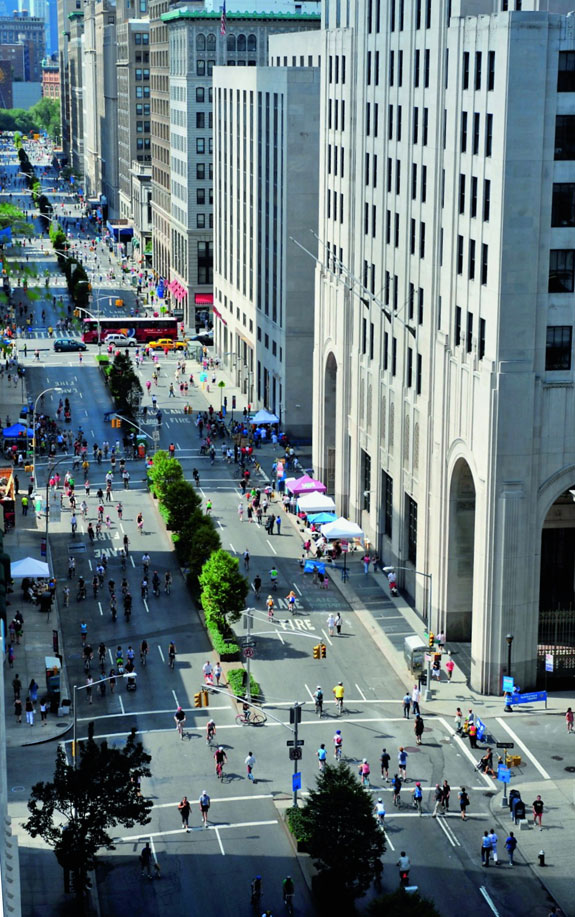
Cities are wonderfully innovative in their efforts to strengthen a broader bicycle culture and demonstrate that bicycles are an obvious choice for almost everyone. Schools offer intensive bicycle training, companies and institutions compete to have the highest percentage of bicyclists among their employees, and information campaigns, bicycle weeks and car-free days are held. Many cities now open bicycle streets on Sunday in campaigns to develop bicycle culture. Sunday is a particularly good day for two reasons: car traffic is usually limited and people usually have more time for exercise and experiences. The idea of closing city streets to car traffic, turning them into temporary bicycle streets instead, has been popular in Central and South America for years. The extensive “Ciclovia” program in Bogotà, Columbia is one of the best known and best developed initiatives of this kind. In the post-millennium years, the idea of reinforcing bicycle traffic has spread to more and more of those cities where cars have dominated planning for decades.
Ambitious strategies have been developed to establish extensive bicycle networks in the large Australian cities Melbourne and Sydney. Planners in both cities are hard at work laying out new bicycle lanes and moving existing lanes away from traffic and into safer “Copenhagen-style bicycle lanes” where bicycles move inside the rows of parked cars. New York City planners are working on a new traffic plan that will make NYC one of the world’s most sustainable metropolises.
New York City’s building density, flat terrain and wide streets provide good opportunities for converting car traffic to bicycle traffic, and a new bicycle network of 3,000 km/1,800 miles of bike lanes is planned for the city’s five boroughs: Manhattan, Bronx, Queens, Brooklyn and Staten Island. Work on the new bicycle lanes started in 2007 and already in the course of 2007 – 2008 about one-quarter of the planned bicycle lanes have been established and significant growth in bicycle traffic is evident. In New York the idea of closing streets to car traffic on Sundays, which NYC calls “summer streets,” was introduced in 2008 as a popular link to the efforts to develop a new bicycle culture.
In the future, concern about sustainability, climate change and health will most certainly mean that increasingly more cities, like New York City, will double their efforts to develop a new culture for city life and movement. Increased bicycle traffic is an obvious answer to many of the problems cities struggle with worldwide.
Bicycling in Economically Developing Countries
Bicycle traffic already plays a key role in the overall traffic picture in many cities in economically developing countries. However, bicycle traffic is typically given poor and dangerous conditions. People bicycle by necessity, and individual mobility is often a prerequisite for being able to get to work and earn a living. In many cities bicycles or bicycle rickshaws handle the lion’s share of goods and people transport. Dhaka in Bangladesh has 12 million inhabitants, and the city’s 400,000 bicycle rickshaws ensure cheap sustainable transport as well as providing a modest but vital income to upwards of one million people.
Many of the cities that actually have extensive bicycle traffic today unfortunately also have forces at work to reduce bicycle traffic in favor of more room for vehicular traffic. In Dhaka, for example, bicycle taxis are considered a problem for the ongoing development of the city. Small motorcycles have replaced bicycles in many cities in Indonesia and Vietnam. Only a few decades ago, large Chinese cities were world famous for their volume of bicyclists, today bicycle traffic has in many cities almost disappeared from the street scene due to traffic reprioritization or even direct bans on bicycles.
In this category of cities, giving bicycle traffic a higher priority needs to be a key ingredient in a policy aimed to effectively utilize street space, reduce energy consumption and pollution, and provide mobility for the great majority of people who cannot afford cars. In addition, investing in bicycle infrastructure is affordable in comparison with other types of traffic investment.
New direction and reprioritizing of city policy is underway throughout the world. Fortunately, this includes prioritizing bicycle traffic in many cities in economically developing countries such as Mexico City and Bogota, Columbia.
Stay in touch
Sign up for our free newsletter
